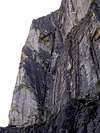|
|
Route |
|---|---|
|
|
38.79940°N / 120.135°W |
|
|
Technical Rock Climb |
|
|
Half a day |
|
|
5.7 |
|
|
Overview
Corrugation Corner is one of the moderate routes on the Main Wall, and ascends a steep and direct line. It runs alongside Traveler Buttress, one of Steck and Roper's Fifty Classics, for 3 pitches. The line is steep and direct, up one of the tallest sections of the cliff. The 2nd pitch is sustained 5.7, not just a couple of moves, and the exposure when you leave the corner and gain the arete gets your attention. The finish is at the same spot as Traveler, so you get a taste of what that route is like.
This route was first climbed by K. Edsburg et al in the early 1960s. Not much info on the 1st ascent.
Approach
Leave the Pony Express Trail abeam the Lower Buttress, and follow a use trail toward the Lower Buttress which will then contour the Lower Buttress to the left and gradually the use trail will improve as it heads toward the Main Wall, and then trends to the right up a gully. The use trail is well-defined up the gully, and passes Tombstone Ledge before it branches left to gain the Main Ledge. Turning on to Tombstone Ledge is a route-finding error that many have made. It is possible to climb up to Main Ledge from here, but it is 5th Class. (Traveler Buttress begins on Tombstone Ledge). Once you are sure you are on Main Ledge, traverse left until it goes into a huge corner. This corner is Corrugation Corner.
Route Description
Pitch One is not too difficult, mostly 5.6 or less, and there are a couple of old soft-iron fixed pins you can clip as you go by. This pitch actually follows the inside of the corner, and is well protected. The route ascends into an alcove, and it is tempting to belay from here, but it is better to ascend diagonally right to a comfy belay ledge.
Ptich Two is definitely the crux of the route, one of the steepest 5.7s I've ever climbed. Start out following the corner, but before it gets too difficult, about 30' up, traverse out left on good holds towards the arete. The route turns and continues up on the edge of the arete. The pro is slim here for a while, and the climbing is sustained. As you start up the arete, it seems that while the holds are there, they are sloping the wrong way (down). The arete offers a pretty good stretch of runout before you can finally place that #1 Camalot vertically between 2 small ribs. From here to the belay is easy, except for the belly-whop into the chimney, which is horizontal at this point. Slither along the ledge (there is only about 3' of head clearance) until the chimney turns vertical, and set your belay here.
Pitch Three is much more casual, once you get out of the chimney. When you leave the belay, you must go up the chimey a little ways, and then traverse right across the block that forms one side of the chimney. This gets you back in the corner, follow the corner until it runs out, and then ladder-climb some of the largest, most comfortable dikes you have ever seen. Literally, some of these are 12-18" incut ledges, if it weren't for the steepness, these might be 3rd class. If your rope lengthallows, belay from the top.
The descent is best made to the northeast. There is a well established use trail in the forest below the crest of the summit, usually within about 250 feet of the crest. This trail takes you over the East Wall and down to the Pony Express Trail adjacent to the Hogsback. It is also possible to descend to the southwest, but this is much more difficult and steep, and is not the preferred route. It looks shorter, and probably is, but only in distance, not in time. I've done both, and I recommend the northeast option.
Essential Gear
A standard trad rack, comfy edging shoes (it won't hurt if they are adept at smearing as well), and some descent shoes. For a detailed gear listing, as well as a topo, check out the free Supertopo, it offers a lot of good info.








